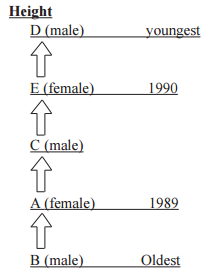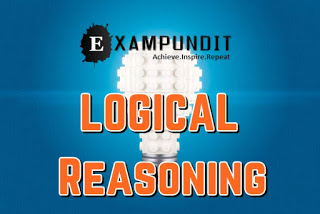Hello and welcome to ExamPundit. Here is a set of Reasoning Quiz for Bank Exams 2015.
Read the following information carefully and answer the following questions:
and different ages. There are two females and three males. A is taller than
only B. E is shorter than only D. Two females are not immediately next to each
other. The ascending order of these friends on height exactly places them in
descending order of their ages. The persons who are at extreme ends are not
females when they are arranged in order of either height or age. A was born in
the year 1989. E is exactly one year younger to A.
person?
might have been born?
shortest person as well as the oldest person?
ladies in the group?
younger to ‘A’ in these group of friends?
| Solutions -The given statements have to be understood as follows;
‘A is taller than only B’ means that A is taller than B but shorter than C, D and E. ‘E is shorter than only D’ indicates that D is the tallest and E is the second tallest. As the order of height and that of age are reverse to each other, tallest person is the youngest person and the shortest person is the oldest. |
||
|---|---|---|
 |
||
10): In the following questions, the symbols $,@,%,© And # are used with the
following meanings as illustrated
below:
‘Q’.
statements to be true, find out which of the two conclusions I and II given
below them is/are definitely true. Give answer
N©R, P@W, R%P
| Solutions – C > Q ≤ E > B. We can’t compare C and B. Hence, conclusion I is not true. Similarly, we can’t compare B and Q. Hence, conclusion II is also not true. |
|---|
7. Statements:
B#E, C©Q, Q@E
| Solutions – C > Q ≤ E > B. We can’t compare C and B. Hence, conclusion I is not true. Similarly, we can’t compare B and Q. Hence, conclusion II is also not true. |
|---|
G$T, T%V, Q©V
| Solutions -Q > V = T ≤ G Q > T Hence, conclusion I is true. V ≤ G Hence, conclusion II
is also true.
|
|---|
D@F, S#G, G$D
| Solutions -S < G ≥ D ≤ F. We can’t compare S and D. Hence, conclusion I is not true. Same is the case with F and G.
Hence, conclusion II is not true.
|
|---|
| Solutions -A ≤ M < D ≥ C. As we can’t compare M and C, conclusion I is not true. A < D.
Hence, conclusion II is true.
|
|---|
Regards
function answer(id){
if(document.getElementById(id).style.display == “block”){
document.getElementById(id).style.display = “none”;
}else{
document.getElementById(id).style.display = “block”;
}
}
#a1{display:none;}
#a2{display:none;}
#a3{display:none;}
#a4{display:none;}
#a5{display:none;}
#a6{display:none;}
Team ExamPundit
Sponsored
(adsbygoogle = window.adsbygoogle || []).push({});
Books For 2015 Banking/Insurance Exams




